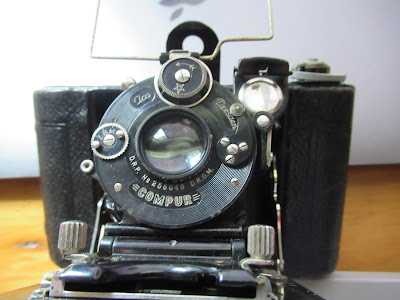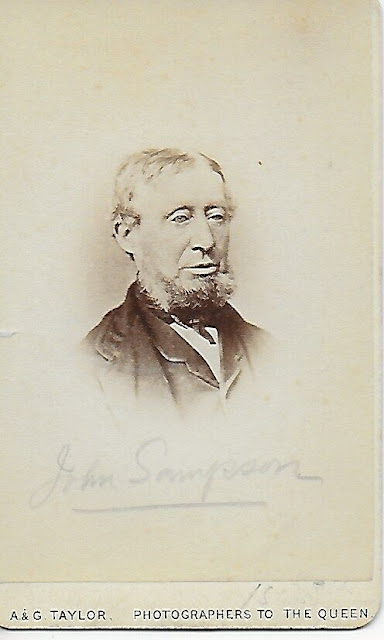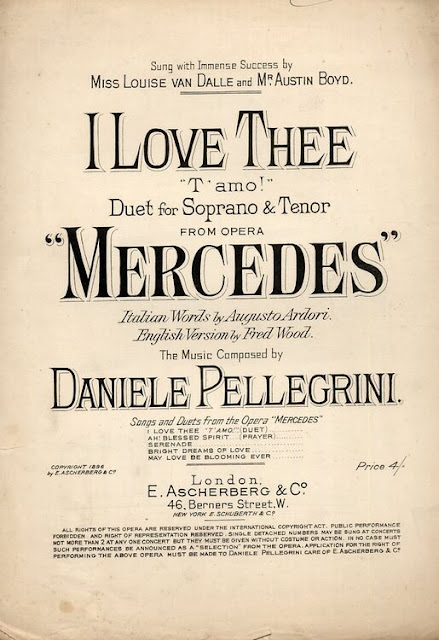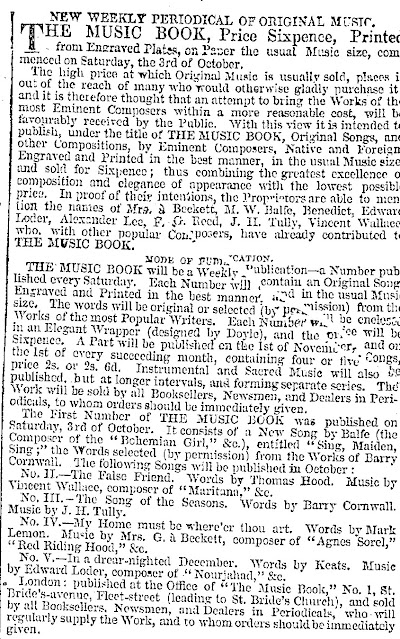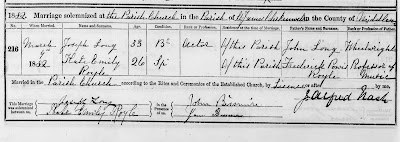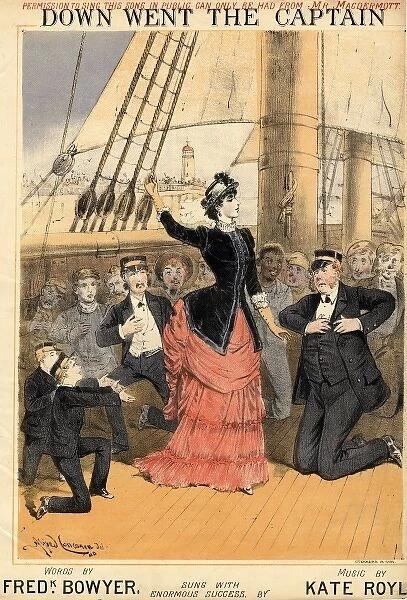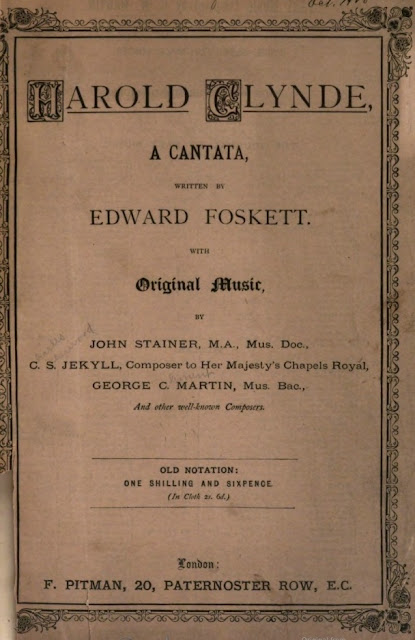MARRIOTT, Annie [Augusta] (b Nottingham, 26 May 1858; d Croydon 1931)
Soprano Annie Marriott was one of the outstanding English oratorio singers of the later part of the 19th century.
She was born in Nottingham into a family which was associated with the trade of silk lace-making. Father William (d 69 Shepherd’s Bush Road, 27 April 1912) was a manufacturer of lace, and the family of her mother, Rebecca née Miller, were all connected with the lace- and dressmaking businesses.
The family, however, were musical – Rebecca’s sister, Eliza Ann, taught singing, William would eventually throw in lacemaking to become a music publisher (Marriott and Williams), and at least three of his children – eldest son William, Annie and her younger sister Edith Rebecca (b Nottingham, 1857; d 13 Clipstone Avenue, Nottingham, 14 March 1928) – became vocalists, the two girls professionally.
I first spot Annie in 1874, when the Nottingham Sacred Harmonic Society, under Henry Farmer, was rehearsing its performance of Fridolin, prior to the arrival of the Sherrington sisters, Gustave Garcia and Hilton. Sixteen-year-old Annie stood in for the prima donna, and William depped for the men.
Soon after, Annie shipped off to London, for a course of lessons at the new (and short-lived) National Training School, under John Bacon Welsh and Arthur Sullivan. She was noticed at the college concerts for her ‘powerful and musical soprano voice’ (‘I will extol thee’), and I spot her in public 25 October 1878, at the Camden Athenaeum, giving ‘O luce di quest’anima’ and ‘Tell me, my heart’, alongside Bridson, Seligmann and others of less fame.
Three weeks later, she was up at St James’s Hall, singing in the Boosey Ballad Concerts. She sang Sullivan’s ‘Let me dream again’ in ‘a powerful and sympathetic soprano’ and was judged ‘gifted ... a fine career is open to her…’ and ‘a decided success’. She appeared at several more Boosey concerts in January, performed, with fellow students Frank Boyle and Frederic King, at the Hackney Choral Association and, on 22 February 1879, made a first appearance, of what were to be very many, at the Crystal Palace, alongside Charles Santley, singing Mendelssohn’s ‘Infelice’ ‘exceedingly well’ and with ‘undoubted intelligence’.
She appeared at de Jongh’s Manchester concerts, at the Huddersfield Ballad Concerts, gave her ‘Infelice’ at her teacher’s St James’s Hall concert, visited Belfast for a Creation and Darlington for Namaan, and was engaged for the Saturday and Monday pops (‘Zuleika’, ‘Luisinghe più care’, ‘Deh vieni’, ‘Lovely Spring’). Still within the first months of her career proper, she sang at the Crystal Palace Easter and Bank Holiday concerts, on more Boosey Ballad programmes (Behrend’s ‘Joan of Arc’), at the Moore celebration (‘Rich and rare’), at the Oxford Commemoration (Loreley), and at the Covent Garden proms series, while journeying regularly to the north and midlands in concert (‘The Worker’, ‘Tell me, my heart’, ‘Beauty sleeps’, ‘Bel raggio’, ‘Deh vieni’, ‘O luce di’) and oratorio (The Messiah, The Woman of Samaria.) ‘Every effort on her behalf was a triumph’, commented the Worcester press after her appearance in The Mount of Olives and Israel in Egypt. Israel in Egypt was also the oratorio in which (25 April 1879) she made a first appearance, alongside Mme Patey, Lloyd and Henschel, at London’s Sacred Harmonic Society.

The season of 1880 found the young singer thoroughly established in her profession. She sang repeatedly at the Boosey concerts (‘The soldier tir’d’, ’When the heart is young’), the Saturday and Monday pops, and at the Crystal Palace (Choral symphony) returned to the Sacred Harmonic Society for The Messiah and Israel in Egypt, sang Hiller’s Song of Victory with Joseph Barnby at Kensington and covered the country, singing principally in sacred music. In the course of twelve months or so, I pick her up at Chester (Messiah), Nottingham (Elijah, Eli), Birmingham (Messiah, Elijah), Southampton (Die erste Walpurgisnacht, Loreley, ‘Ocean thou mighty monster’), Wolverhampton (The Bride of Dunkerron), Oxford (Israel in Egypt), Lowestoft (Messiah), Huddersfield (Macfarren’s Joseph), Glasgow (Moses in Egypt) … and there were undoubtedly many more such.
1881 included dates at the Albert Hall (Stabat Mater, Lobgesang, Messiah, Scottish concert), the Hackney Choral Society (Goring Thomas’s ‘Hero and Leander’), and the Sacred Harmonic Society, where she sang in Samson, The Messiah and in Sullivan’s The Martyr of Antioch, which work she repeated several times in various parts of the country, at the Crystal Palace and the Alexandra Palace and Hengler’s Proms, and in September she joined Emma Albani and Anna Williams at the top of the bill for the Three Choirs Festival at Worcester (The Widow of Nain, Jephtha).
Her list of provincial engagements was as heavy as the previous year, and ranged from the predictable Messiahs to such less-performed works as Bridge’s Boadicea (14 November 1882) which had been created by Marie Roze at the Chester Festival.
When Annie appeared at the Crystal Palace in December, she was joined by her sister, mezzo-soprano Edith, also for some years a stalwart of the Nottingham Sacred Harmonic Society, who would appear both in duet with Annie, and as a single, with considerable success – initially under the name of ‘Edith Miller’ -- over the years to follow.
The Martyr of Antioch continued to be a regular on Annie’s programme, and she returned to the moribund Sacred Harmonic Society 24 February 1882 to, once again, sing the role created by Albani (‘natural charm of her voice ... intelligent rendering of the difficult music assigned to her’) alongside the other original soloists. At the age of twenty-four.
In the same month, she performed the Choral Symphony at the Philharmonic Society and, on May day, she joined Shakespeare and Frederick King to create the role of Alswitha in Ebenezer Prout’s Alfred, with his enterprising Hackney Society.
In June 1882, she shared the soprano duties with Mary Davies at the Chester Festival (The Prodigal Son, Woman of Samaria. Elijah) and, in the latter part of the year, she went on a concert tour with Edith, Helen D’Alton, Boyle/Henry Guy and Thurley Beale.
The Crystal Palace continued to be one of her preferred venues, and during 1883 she appeared there in a repeat of Alfred, in the Saturday concerts, the Choral Symphony, a selection from Mackenzie’s opera Colomba and in the much touted ‘8th triennial Handel Festival’. She shared the soprano music with Albani and Alwina Valleria, acknowledgedy the two most prized soprano vocalists of the day. Annie, with Anna Williams and Mary Davies, was already in the top division of the local sopranos.
She appeared with the revived Sacred Harmonic Society (Lobgesang, Christmas Oratorio), in the Choral Symphony at the Richter Concerts, in Gaul’s Holy City, Cowan’s St Ursula, Farmer’s Christ and his Soldiers and other more regular works, in various parts of the country, sang at the National Eisteddfod at Harlech, the Halle concerts at Liverpool and, in October, joined Valleria and Williams in the Leeds Festival (Elijah, The Crusaders, Lobgesang &c).
Among the local small part soloists was Leeds’s Percy Palmer, a light tenor. In half a dozen years’ time, Annie would become Mrs Palmer.
In the following years, Annie Marriott was repeatedly seen in London, at the Crystal Palace (Choral Fantasia, Mors e vita, Redemption, Handel bicentenary, Good Friday concerts, Dvorak’s St Ludmilla, Mackenzie’s The Story of Sayid), with the Sacred Harmonic Society (Belshazzar, Woman of Samaria, Mount of Olives, Creation, The Messiah), at the Richter concerts (Beethoven Mass in D), at the Albert Hall and the Covent Garden proms (Elijah, Messiah, Sullivan’s ‘Over the roof’).


Having been the first to introduce its music to London, at the Covent Garden Proms, days after it premiere at the Birmingham Festival, she gave a number of performances throughout the country of Dvorak’s The Spectre’s Bride (‘she has made it peculiarly her own’), confirmed her connection with the National Eisteddfod, sang the Lobgesang in Westminster Abbey, and continued with her run of lesser known works – Goring Thomas’s The Sunworshippers, Jansen’s The Feast of Adonis, Bridge’s Rock of Ages, Mackenzie’s The Bride, Prout’s Hereward, Cowen’s The Sleeping Beauty around Britain.
On 11 May 1887, she was commanded to the Palace, to give a private performance for Queen Victoria, on the occasion of her Golden Jubilee, and on 22 June sang the second soprano part to Albani in Mackenzie’s Jubilee Ode premiered at the Crystal Palace.
In the same year she sang at the Huddersfield Festival (7 October) premiering Prout’s The Red Cross Knight, and at the Norwich Festival (The Messiah, Dvorak’s Stabat Mater, Bottesini’s The Garden of Olivet, Jubilee Ode, Cherubini’s 4th Mass in C) where she made an unaccustomed venture into the semi-operatic by singing the role of Margaret, alongside Lloyd and Santley, in Berlioz’s Faust.
A fortnight later, she sang the part of Donna Anna in a concert of Don Giovanni at the Crystal Palace (29 October 1887), given to mark the centenary of its production. She ‘sang admirably and fully justified a reputation which has long been great and has recently been rapidly increasing’ wrote the press, crediting her with ‘true dramatic power and expression’. But – even though the press might label her ‘one of the most dramatic of dramatic sopranos’ -- Annie Marriott was not veering towards an operatic career. This was just about the closest she would ever get to going on the stage.
She repeated Bottesini’s cantata when it was given a London showing by the Sacred Harmonic Society (17 November 1887) with Hilda Wilson Lloyd and Santley. She returned for the next Handel Festival, to sing in support of Valleria in Israel in Egypt and, in doing so, became part of a memorable occasion. The performance was recorded, live, and became – so it is said – the first ever recording of a classical music concert.
https://www.youtube.com/watch?v=4JSx837JiNQ
In 1889 (20 July), Annie Marriott became the wife of [James] Percy PALMER (b Flaxton, Yorks 17 December 1860; d 32 Victoria Grove, Fulham Rd, 10 August 1893) whose small career as a tenor singer he had renounced in favour of teaching. It would be a short marriage, for Palmer died at the age of 32, and his second son was born posthumously. Dr Bridge played the organ at his funeral and Harper Kearton sang the anthem.
Annie sang in Bridge’s Callirhoe and The Repentance of Nineveh, Benoit’s Lucifer and became a favourite choice for Albani’s role of Elsie in performances of Sullivan’s The Golden Legend, and just once more took an ‘operatic’ engagement when in December 1891 she sang a concert Faust with Julia Lennox, Henry Guy and Henry Pope for the Batley Choral Society.
From this time, Annie Marriott was less frequently seen. She still visited Scotland in concert and oratorio, she still went to Bristol or Dewsbury to sing Cowen’s St John’s Eve or Parry’s Ode on St Cecilia’s Day or Cardiff for The Sleeping Beauty. When the National Sunday League oratorios began in 1894, she sang the soprano roles in The Last Judgment, Judas Maccabaeus, Rebekah and Redemption.
But now, she was ‘Madame Annie Marriott’ and an adjudicator for the prizes awarded by the Royal Academy of Music. And a music teacher at the Crystal Palace.
On 9 June 1897, she sang in the stillborn oratorio The Death of Moses at the Queen’s Hall, and my last sighting of her as a performer is on 30 November 1900, when she surfaces singing Athalie with the West Ham Choral Society.
Annie was now remarried, her new husband (8 August 1898) being a French-born photographer, Paul Lacroix (d 58 Coningby Rd High Wycombe 15 November 1958). Thereafter, I find little of Annie. She apparently had a daughter in 1901, she is living in Fulham both in 1909 and in the 1911 census, described as singing teacher’ and, in 1915, when her son, Percy Reginald, was killed in action in Belgium, she was ‘of Camden Rd, Holloway’.
But she seems to have left the world of music.
So fully had she left it, that I can find no trace of her death, except for the entry ‘Annie A Lacroix’ in the death registers for Croydon, 1931. While minor figures get half a column of obituary here and there, the woman who was one of England’s best soprano vocalists of the 1880s is just allowed to vanish. Another one.
Edith Marriott also married, a hosiery manufacturer, from back home in Nottinghamshire, by the name of William Edwin Elliott and retired to a life, with four children, on home ground.
William seems to vanish as a singer after 1880.
Father William dissolved his publishing company, remarried when over 80, and, when he died in 1912, was said to be ‘of Keith, Prowse’.




